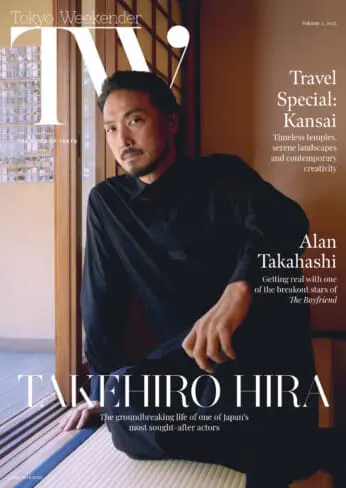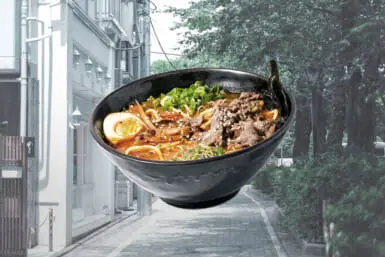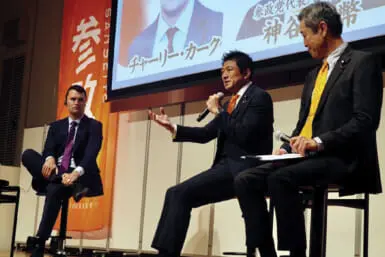by Elyse M. Rogers
OVEREATERS ANONYMOUS (OA)
When you get your weekly copy of the Tokyo Weekender, you probably have your own system of reading it. You might look first at the cover feature, go to your favorite column (I hope mine is a “favorite” for some), and on to other columns, features and advertisements. Even if you’re not particularly interested in finding a new rezoko (refrigerator) or a handsome Toyota, you probably eventually turn to the classifieds. At least I do, and that’s where I first read about an organization called Overeaters Anonymous in Tokyo.
Recently I called that number and reached a charming young woman who gave me a little information about the organization and invited me to a meeting. I made my way to St. Alban’s Episcopal Church in Tokyo one Saturday morning to learn more about the organisation and the kind of people who are members.
The meeting had just started when I walked in, and a member was reading some of the group’s philosophy, while others sat around in a circle. I’m not sure what I expected the group to be like, but the reality was a surprise—a group of perfectly ordinary human beings. There were some overweight individuals, of course, but many were well within the normal weight range and a few were downright skinny. Certainly not what I expected from a group of “compulsive overeaters.”
The format of the organization and the meeting structure is very similar to Alcoholics Anonymous and that was evident right from the start. Good humor prevailed throughout the meeting, with a lot of laughter, a few emotional confessions and a lot of interesting conversation.
If there was one thing absent during the meeting it was any kind of disapproval or condemnation. “We’re all in this together, and we’re here to help each other,” is not just dry philosophy printed in the literature, but a course of action that pervades every meeting.
THE HISTORY OF OA
The saga begins, as many such sagas do, with one person. In this case it was a woman who had been heavy all her life, was very unhappy about it, but found that ordinary dieting just didn’t work. Somehow huge quantities of food and compulsive eating were all tied up with her life, her goals, her ego and her self-worth.
She was depressed, hopeless and suicidal when a fortuitous event occured: in order to try to help a friend of her husband who was a compulsive gambler, she attended a GA (Gamblers Anonymous) meeting. As she writes it, “I will never forget that night. I sat there transfixed and thought, ‘My God, I’m not alone after all.'” Although the compulsions were not the same, she felt that “inside we were the same.”
Wondering if the same tactics might work for her and others who had eating problems, she went to a friend who was active in AA (Alcoholics Anonymous) and asked for his opinion on the matter. He agreed and offered his help.
Like most things in life, the OA program didn’t materialize quickly or easily. But it did finally materialize and it’s interesting that one of the reasons it finally did “get off the ground” is because the founder changed her tactics and approach to others.
As she tells it, “With my usual self-willed zeal I sailed into saving the world. Unfortunately all the 25 or 30 women I approached had one excuse or another for not joining me in this marvelous enterprise. I did not realize I was preaching at them, telling them what a great idea this was for solving their very evident problem.
“One crisp January day I was walking down the street with my very overweight neighbor, chatting as we both pushed our babies in strollers. I remember telling her about my problem and my solution, never once intimating that she had the same problem. Finally she was so intrigued she coaxed me into telling her the name of the organization. I told her and then said, ‘But I know you won’t be interested.’
” ‘Oh yes I am,’ she said, ‘I think I need it too.’ At that moment the Fellowship of Overeaters Anonymous was born.”
That attitude of “fellowship” versus “preaching or dictating” is the backbone of the organization today.
The Tokyo OA organization was started about six or seven years ago by a woman who came to Japan to work and wanted to continue with the OA affiliation she had left behind in the States. Currently there are 14 groups in Japan and an Intergroup which has representatives from the different OA groups in the area and functions to provide better service to OA members or would-be members.
THE GROUP TODAY
Since the founder was female and initially tried to recruit “other women” you may have the impression that OA is for women only. Not so! At the meeting I attended, about one-third of the 20 people were men. “Compulsive overeating” and other “eating disorders” strike either sex.
The groups in Japan are part of the larger, global OA organization headquartered in California (address at the end of the column). The Tokyo group is part of Region Nine, a huge region—consisting of all OA groups (434 of them) outside of North America, including such countries as Austria, Egypt, Saudia Arabia and Zaire.
To make the large region more personal, it was divided into three districts. Japan is in District 3, which includes 160 OA groups in Asia along with Australia and New Zealand.
There are no dues or membership cards for OA but it is supported by voluntary donations from those who attend meetings. Any money the organization accumulates is shared as follows: 30% goes for World Service, 10% to the Region and 60% to the local Intergroup. Being part of the global network not only creates a feeling of unity but brings concrete advantages as well. Brochures, newsletters and directories come : from the central office.
I should emphasize that the “anonymous” part of the group’s name is extremely important. No member is identified by other than his/her first name (although among individual members last names are often known, of course) and no member’s name is allowed to be listed in the media, even if he/she has no objection.
PURPOSE OF THE GROUP
OA members emphasize that they are not a weight-reduction group; in fact the organization has even eliminated their original diet-plan information. A new pamphlet was approved at the May World Service Conference in Los Angeles entitled “OA Is Not a Diet Club.”
As one Tokyo OA member told me after the meeting, “None of us needs diet information—we’ve all been on almost every published diet before coming to OA.” But if a diet plan is needed by an individual, doctors or nutritionists will happily supply a suitable one.
If OA isn’t a diet group and doesn’t provide diet plans, you may well be asking yourself just what it does do. I was prepared to ask that same question but I never had to. The meeting answered it for me. OA is an organized support group with a well-defined “Twelve Steps” program, for complusive over-eaters or anyone with an eating disorder.
The object is to “arrest the disease” (like AA, members believe there is no cure, just “disease-free” days, months and hopefully years), so that members can function more adequately in society, without the food compulsion that previously dominated their lives.
ABSTINENCE
Perhaps the core of the program is “abstinence.” When I first heard group members using this word, I was intrigued. Certainly one cannot abstain from food throughout life (as one can with alcohol or gambling) and survive. But “abstinence” for the OA member has a slightly different meaning: it refers to abstaining from the compulsive eating behavior (such as going on food binges), which has him/her overweight (usually), unhappy, guilty and with lives “out of control.”
Abstinence is aided by gaining a new philosophy of life— mainly admitting that one is powerless over food and turning one’s life over to a “higher power” for help and guidance.
OA is dedicated to serving those with all types of eating disorders, including anorexics (those who have a distorted image of their body and discipline themselves to eat so little that they can actually starve to death) and bulimics (those who go on eating binges and then force themselves to vomit to retain a normal or low weight).
INFORMATION ABOUT OA
For those who would like written literature, some is available at OA meetings or you can write to Overeaters Anonymous, World Service Office, P.O. Box 92870, Los Angeles, CA 90009.
Tokyo OA programs are held on Saturdays at 12:30 p.m. at St. Alban’s Church, and at the Tokyo Union Church on Sundays at 5:30 p.m., Mondays at 12:30 p.m. and Thursdays at 6:30 p.m. A phone answering machine provides a short tape with basic information on OA and meeting dates and times, etc. The answering machine number is 630-3118. If you’d rather get information from a real live person, call 423-2067.
External Link:
Overeaters Anonymous








